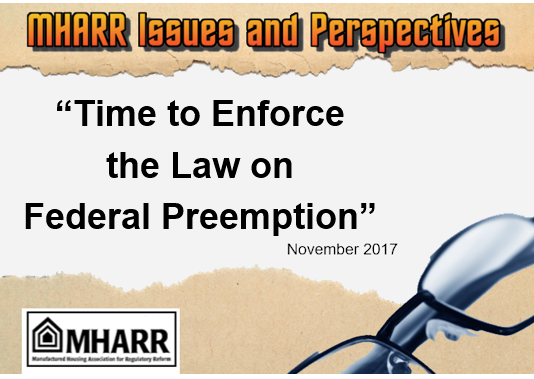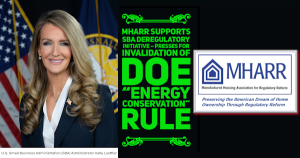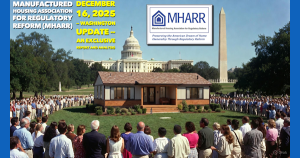While a discussion of federal preemption may lead eyes to glaze-over in some quarters, a consistent and logical approach to preemption – that is fully consistent with the law as it exists today — is vitally important to the manufactured housing industry and, even more so, to consumers of affordable housing. And having that discussion now, is crucial and, indeed, necessary, with a new Administration in the White House committed to regulatory reform, and the nomination of a new HUD General Counsel pending before the United States Senate.
Federal preemption – as MHARR has consistently stressed — is one of the truly key elements of federal manufactured housing law. A preemption provision was thus included by Congress in the original Manufactured Housing Construction and Safety Standards Act of 1974. Later, that provision was significantly strengthened and expanded by Congress as part of the Manufactured Housing Improvement Act of 2000. The implementation of that provision, however, rests in the hands of the Executive Branch of the federal government – in this instance, HUD. And HUD, unfortunately – particularly during the four-year tenure of its current manufactured housing program administrator – has made an utter mess of what should (and, indeed, must) be robust and potent federal preemption that is clear and predictable for all federal program stakeholders. The good news, though, is that the current morass can be untangled and resolved in a way that complies with existing law, given proper leadership at the top of the federal program and within HUD’s Office of General Counsel (OGC).
Federal preemption can occur in one of two ways. A federal law, adopted by Congress, can specifically state that it – and valid enactments pursuant to its authority – preempt state and local enactments within the same field. This is referred-to as “express” preemption. Alternatively, federal preemption can be inferred by a court when a federal enactment conflicts with parallel state and/or local enactments. This is referred-to as “implied” or “conflict preemption.” In addition, preemption itself can be either complete or partial. In some cases, Congress will expressly occupy an entire field of activity or commerce. In others (and in most “implied preemption” cases), the preemption is more limited and must be analyzed and decided on a case-by-case basis.
For manufactured housing, federal preemption is express, not implied, insofar as the law (in section 604(d)), expressly states that HUD enactments, pursuant to the Act’s authority, are preemptive. The law, however – both as originally stated and as amended later by the 2000 reform law – does not fully preempt the entire field of manufactured housing construction, safety (and later installation) regulation. Instead the law states:
“Whenever a federal manufactured home construction and safety standard established under this title is in effect, no state or political subdivision of a state [i.e., locality] shall have authority either to establish or to continue in effect … any standard regarding construction or safety applicable to the same aspect of performance of such manufactured home which is not identical to the federal … standard.” (Emphasis added).
In the era before the 2000 reform law, the pivotal question, in each preemption situation, was whether the federal standard and the state or local standard in question, both addressed the “same aspect of performance” of the home. And HUD, to its credit, for more than a decade following the enactment of the law, construed the scope of federal preemption under the law and, more specifically, what did or did not constitute the “same aspect of performance” of a home, in a relatively broad manner. In a 1989 decision, for example, the then-director of the HUD manufactured housing program ruled that an Oklahoma City fire sprinkler ordinance for manufactured homes was preempted, stating: “If your municipal requirements include automatic fire sprinkler systems, they address the same aspect of performance as HUD’s standards, i.e., fire safety. Therefore, HUD’s standards preempt.” (Emphasis added).
During the 1990’s, however – and still prior to the enactment of the major preemption changes contained in the 2000 reform law (as shown below) — HUD OGC radically shifted course on federal preemption as revealed in legal memoranda obtained by MHARR under the Freedom of Information Act (FOIA). In those memoranda, OGC argued that the law’s “same aspect of performance” language should be construed in a narrow and restrictive fashion based on court decisions interpreting similar language contained in the National Traffic and Motor Vehicle Safety Act of 1966 (NTMVSA) (i.e., Chrysler Corp. v. Tofany and Chrysler Corp. v. Rhodes). This shift, based on an extremely narrow construction of the “same aspect of performance” proviso, led to a series of HUD decisions (never since retracted), holding that state and/or local fire sprinkler mandates are not federally preempted because the federal “fire safety” standards for manufactured homes involve passive measures, such as “reducing fire hazards” and “providing measures for early detection,” rather than “mechanical devices … [to] retard the spread of fire in a home.”
While MHARR vehemently disagreed with these decisions (and still does), this narrow view of federal preemption should have changed completely in the wake of the preemption amendments contained in the Manufactured Housing Improvement Act of 2000. Among other things, that law added a new sentence to the original preemption provision, stating:
“Federal preemption under this subsection shall be broadly and liberally construed to ensure that disparate state or local requirements or standards do not affect the uniformity and comprehensiveness of the [federal] standards promulgated under this section nor the federal superintendence of the manufactured housing industry….” (Emphasis added).
With this statutory amendment, Congress made two key changes to federal preemption. First, it legislatively overruled – with express, unequivocal and unmistakable language – HUD OGC’s determination that the scope of federal preemption should be construed narrowly. Second – and, again, directly contrary to HUD’s narrow approach to preemption — it explicitly expanded the scope of that preemption. Thus, while HUD had previously ruled that the federal standards could only preempt state or local construction or safety standards, the 2000 reform law expressly expanded the reach of federal preemption to also include state or local “requirements” that interfere with federal “superintendence” of the industry and, by natural extension, to the accomplishment of the federal law’s purposes, including expanding the availability and affordability of manufactured housing (think placement restrictions).
So what did HUD do with all this, post-2000 law? Initially, it twisted itself into intellectual knots trying to pretend that the 2000 law actually changed nothing regarding preemption. In discredited “guidance” regarding then-“Recent Program Activity,” HUD stated: “Does the 2000 Act expand the scope of federal preemption? No, though revised language in section 604(d) does require that the original preemption provision be ‘broadly and liberally construed,’ HUD does in fact take a broad and liberal view with regard to preemption of state and local standards when they actually conflict with HUD’s Manufactured Home Construction and Safety Standards.” (Emphasis added).
HUD’s assertion that it was already taking a “broad and liberal view” of preemption under the Rhodes and Tofany cases, before the 2000 reform law, is laughable. The courts in both of those cases concluded that the “same aspect of performance” language in the NTMVSA statute should be construed narrowly. The Tofany court, in fact, stated: “we conclude that the ‘aspect of performance’ language in the preemption section of the Act must be construed narrowly.” (Emphasis added). For HUD to claim, then, that before the 2000 law it was already construing preemption “broadly,” under cases which specifically state that preemption is to be construed “narrowly,” is absurd.
The fact of the matter, as founding MHARR President Danny Ghorbani stated in the September 2014 edition of the “MHARR Viewpoint,” is that: “When Congress passed the 2000 reform law, it was well aware of HUD’s microscopic approach to federal preemption and [fire] sprinkler preemption in particular. Thus, the ‘broad and liberal’ provision of the 2000 reform law directly overruled HUD’s unduly narrow pre-2000 interpretation of federal preemption.” (Emphasis in original). Further, for HUD to claim, without any basis whatsoever, that the 2000 law did not expand the scope of preemption under the law – when Congress specifically added “requirements” (and not just construction and safety “standards”) to the type of state or local enactments that could be preempted (and note how the word “requirements” is conveniently omitted from the language quoted in HUD’s “guidance” document) — is again, a misrepresentation of the 2000 reform law. Which makes it all the more incredulous and indefensible that HUD, for over two decades now, has left on the books “Statements of Staff Guidance” regarding federal preemption, adopted before the 2000 reform law, that fail, in any way, to reflect the changes made to federal preemption by Congress.
For more than a decade after the enactment of the 2000 reform law, then, HUD maintained the utterly absurd and unsupportable fiction that the 2000 law did not make any real change to federal preemption and that, as a result, it did not need to change its administrative approach to preemption. This position not only conflicts with the plain meaning and legislative history of the changes made in the 2000 law, but has resulted in significant harm to both the HUD Code industry and the lower and moderate-income American families who depend on manufactured housing as the nation’s premier source of affordable, non-subsidized home-ownership. By continuing an unduly narrow approach to federal preemption, HUD has allowed localities to use alleged “standards” and various other types of mandates, including supposed “zoning” ordinances and requirements, to effectively exclude and discriminate-against the industry, its products and, most importantly, the Americans who seek to purchase and own a manufactured home of their own.
That is, until now – maybe. In two unpublished and largely unpublicized decisions, HUD OGC has actually backed into a construction of federal preemption that is generally consistent with the language and original intent of the law.
In one case, HUD OGC preempted an effort by the State of Minnesota to require an onsite “Blower Door Test” — pursuant to the International Energy Conservation Code (IECC) — for all new residential construction, including manufactured homes. In a July 10, 2014 decision, issued by email to Minnesota state authorities, OGC recites both the preemption provision as amended by the Manufactured Housing Improvement Act of 2000 — with its mandate that preemption be “broadly and liberally” construed — and the preemption provision of the HUD Procedural and Enforcement Regulations (PER) at 24 C.F.R. 3282.11. It then goes on to state: “The Blower Door Test is essentially a standard requiring remedial actions above and beyond what is required by the federal standards…. Thus, the Act and … 3282.11(b) and (c) preempt Minnesota’s enforcement of the IECC standard.” (Emphasis added). HUD also rejected the state’s argument that the “Blower Door Test” was an “installation” standard and thus not subject to federal preemption under HUD’s re-codification of the federal installation standards.
What stands out about this decision, is – finally — the “broad and liberal” nature of its preemption analysis. Unlike past HUD preemption decisions which, as noted above, had focused almost exclusively on whether a state or local standard addressed the “same aspect” of manufactured home “performance” as a federal standard, the blower door decision does not even attempt to identify a federal standard addressing the “same aspect of performance” as the proposed state regulation. Instead, it simply finds — as expected by Congress when it enacted the enhanced preemption of the 2000 reform law – that the state standard requires action “above and beyond what is required” by the “federal standards,” collectively and viewed as a whole. In doing so, it rejected the state’s argument that “when [the] federal standards are silent or do not address a specific code or standard … the state is not superseding the Federal Standard and may enforce state standards.”
Until recently, this unheralded and unpublished HUD decision has stood by itself, as a sort of “outlier” among various administrative rulings regarding federal preemption affecting manufactured housing regulation. That is, until HUD OGC issued an opinion in 2017 regarding federal preemption of local installation standards in federally-administered “default” states. That opinion — initially posted on the website of HUD’s installation contractor, but now apparently “scrubbed” after being highlighted by MHARR — would completely reverse HUD’s previous rulings concerning the preemptive effect of its federal “model” installation standards.
As MHARR has explained in detail previously, the National Commission on Manufactured Housing, in proposing HUD regulation of manufactured home installation in “default” states, expected that the federal installation standards would be codified as part of the Part 3280 construction and safety standards and would, therefore, be fully preemptive, subject to an express exception for state installation programs. Instead, though, HUD — in an action vigorously opposed by MHARR but accepted by MHI — “re-codified” the federal installation standards as a separate Part 3285, and has claimed, for nearly a decade now, that those standards, as a result, are not preemptive at all. Thus, the previously-referenced HUD “guidance” document states: “Does federal preemption apply to the Model Manufactured Home Installation Standards mandated by the 2000 Act? No.” (Emphasis added).
Now, though, after ten years of denying any preemptive effect for its federal installation standards – which has harmed the industry and consumers by allowing the continuation and enforcement of purported local “installation” standards that are, in actuality, discriminatory and exclusionary subterfuges – HUD, incident to a new effort to impose the federal “model” installation standards on states with approved state-law installation programs, has suddenly decided that the federal installation standards are preemptive.
That 2017 OGC opinion – again, now apparently deleted from the installation contractor’s website after being exposed by MHARR — simply sweeps away (and/or ignores) the legal niceties that had previously been asserted by HUD in maintaining that federal installation standards are not preemptive, as well as the previous narrow construction of that preemption outlined above. Thus, the 2017 OGC opinion states: “The [federal] installation regulations do not specifically contain language that addresses whether a local … jurisdiction can issue permits or certificates of occupancy to an unlicensed installer. However, under federal law, the Department is given exclusive authority to regulate manufactured home construction and safety standards, which include installation standards, and in such areas, the Department’s regulations are given supremacy over State and local laws and requirements through the Manufactured Home Construction and Safety Standards Act.” (Emphasis added). This broad and sweeping declaration is directly contrary to all previous statements by HUD with respect to installation standards.
So what, then, is the state of federal manufactured housing preemption as amended by the 2000 reform law? The only accurate answer at this juncture, is “confused and chaotic,” with old, outdated and incorrect pre-2000 law “guidance” still on the books, state installation programs being pressured and threatened to submit to HUD demands based on supposedly non-preemptive federal installation standards, and new, more accurate preemption decisions being “deep-sixed” by a program leadership that seems intent on minimizing preemption when it could help the industry and consumers, and adhering to the original intent of the law only when it can be used to expand federal authority, again to the detriment of the industry, consumers, and state authorities.
MHARR has been a consistent advocate for broad and effective preemption regarding construction and safety standards, where uniform standards and enforcement are the key to affordability. On installation, MHARR has again been consistent with the express language of the 2000 reform law in seeking flexibility for the states and their state law installation programs, which must address varying conditions and circumstances that cannot be properly or cost-effectively regulated by HUD, on a one-size-fits-all basis, from Washington, D.C. At the same time, MHARR has long advocated the preemption of local mandates – whether characterized as construction standards, installation standards, placement mandates or anything else — which effectively are, and function as, a subterfuge for excluding or otherwise discriminating against manufactured housing.
Installation and placement, however, are primarily a post-production matter, and the industry, as well as consumers, have suffered because of the lack of an independent national post-production association that could partner with MHARR in tackling this issue in all of its various forms — pressing for a resolution that would be consistent with the law as it stands today, while benefiting millions of homebuyers around the United States. This is in addition to a myriad of other abuses being imposed on the industry’s post-production sector from Washington, D.C. in the absence of such an independent national post-production association. These major issues include, but are not limited to: debilitating SAFE Act mandates; Dodd-Frank mandates; FHA Title I mandates; the continuing refusal to securitize manufactured home chattel loans on a market-significant basis; baseless, high-cost proposed “energy” standards; baseless restrictions on attached garages; needless on-site construction mandates and restrictions; baseless new requirements for “frost-free” foundations; and HUD’s attempted takeover of installation regulation in “approved” states, to name just a few. While MHARR, as a producers’ association, was drawn into the drafting and passage of the Housing and Economic Recovery Act of 2008 (HERA) due to failures of the broader industry — it has and will continue to aggressively address all of these matters. Ultimately, though, the industry’s post-production sector will realize that these battles will only multiply without an independent, nation association of its own.
All of that said, the time has come for a thorough and honest reassessment of the state of federal preemption under the 2000 law, in order to make it consistent, logical and predictable, to preserve legitimate state authority as provided by the 2000 reform law, and to accomplish the laudable and necessary goals of that legislation. The Executive Order 13777 regulatory review process mandated by the Trump Administration and currently underway at HUD provides a mechanism for that review and MHARR has called for HUD to do just that. In order to accomplish any real change, though, new leadership – as MHARR has publicly advocated – will be necessary at the top of the federal program. Under its present administrator, the program seems to simply gravitate to whatever will hurt the industry (and its consumers) the most. This situation, in all of its various iterations, is unacceptable and demands fundamental change.
Mark Weiss
MHARR is a Washington, D.C.-based national trade association representing the views and interests of independent producers of federally-regulated manufactured housing.
“MHARR-Issues and Perspectives” is available for re-publication in full (i.e., without alteration or substantive modification) without further permission and with proper attribution to MHARR.













